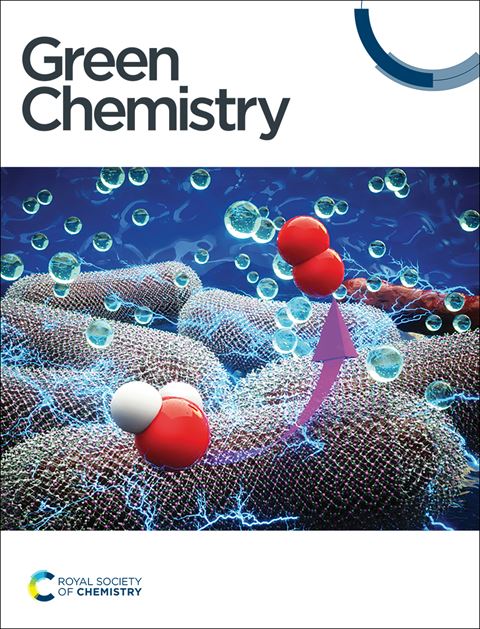通过界面电荷转移,光化学诱导的烷基卤化物与噻吩的非均相催化选择性脱卤偶联
IF 9.3
1区 化学
Q1 CHEMISTRY, MULTIDISCIPLINARY
引用次数: 0
摘要
光电催化协同系统为氧化还原转化提供了新的机制,但传统方法在可持续性和可扩展性方面面临挑战。现有的光电催化还原脱卤偶联方法存在均质染料依赖性、复杂的分裂细胞设置和有限的底物相容性等问题。本文采用可回收的聚七嗪酰亚胺/In2S3 (PHI/In2S3)异质结光催化剂,通过界面电荷转移(ICT),提出了一种绿色节能的烷基卤化物与噻吩选择性脱卤偶联的光电化学策略。通过施加外部偏置电位,我们有效地抑制了光电子-空穴复合,在温和条件下(室温、环境空气、未分裂的电池)实现了高达84%的产率,周转数(TON)高达14090。这种方法不需要牺牲试剂、有毒溶剂或能源密集型设置,同时能够有效地切割C-F / C-Cl / C-Br键。绿色化学的主要优势包括:(1)多相催化剂设计,易于回收和再利用(5次循环后收率保持76%);(2)简化了未分割单元的操作,尽量减少能源和材料的浪费;(3)环境条件下基材范围广,减少有害副产物的形成;(4)原子经济合成药学上相关的二硫缩醛。这项工作建立了一个可持续的范式脱卤化学通过整合光电化学活化与多相催化。本文章由计算机程序翻译,如有差异,请以英文原文为准。
Photoelectrochemical-induced heterogeneous catalytic selective dehalogenation coupling of alkyl halides with thiophenols via interfacial charge transfer†
Electrophotocatalytic synergistic systems offer novel mechanisms for redox transformations, yet conventional approaches face challenges in sustainability and scalability. Existing electrophotocatalytic reductive dehalogenation coupling methods suffer from homogeneous dye dependency, complex divided-cell setups, and limited substrate compatibility. Herein, we present a green and energy-efficient photoelectrochemical strategy for selective dehalogenation coupling of alkyl halides with thiophenols via interfacial charge transfer (ICT), employing a recyclable poly(heptazineimide)/In2S3 (PHI/In2S3) heterojunction photocatalyst. By applying an external bias potential, we effectively suppress photoelectron–hole recombination, achieving up to 84% yield under mild conditions (room temperature, ambient air, undivided cell) with a turnover number (TON) of up to 14 090. This approach eliminates the need for sacrificial reagents, toxic solvents, or energy-intensive setups, while enabling efficient cleavage of C–F/C–Cl/C–Br bonds. Key green chemistry advantages include: (1) heterogeneous catalyst design allowing facile recovery and reuse (76% yield retention after 5 cycles); (2) simplified operation in undivided cells to minimize energy and material waste; (3) broad substrate scope under ambient conditions, reducing hazardous byproduct formation; and (4) atom-economical synthesis of pharmaceutically relevant dithioacetals. This work establishes a sustainable paradigm for dehalogenation chemistry by integrating photoelectrochemical activation with heterogeneous catalysis.
求助全文
通过发布文献求助,成功后即可免费获取论文全文。
去求助
来源期刊

Green Chemistry
化学-化学综合
CiteScore
16.10
自引率
7.10%
发文量
677
审稿时长
1.4 months
期刊介绍:
Green Chemistry is a journal that provides a unique forum for the publication of innovative research on the development of alternative green and sustainable technologies. The scope of Green Chemistry is based on the definition proposed by Anastas and Warner (Green Chemistry: Theory and Practice, P T Anastas and J C Warner, Oxford University Press, Oxford, 1998), which defines green chemistry as the utilisation of a set of principles that reduces or eliminates the use or generation of hazardous substances in the design, manufacture and application of chemical products. Green Chemistry aims to reduce the environmental impact of the chemical enterprise by developing a technology base that is inherently non-toxic to living things and the environment. The journal welcomes submissions on all aspects of research relating to this endeavor and publishes original and significant cutting-edge research that is likely to be of wide general appeal. For a work to be published, it must present a significant advance in green chemistry, including a comparison with existing methods and a demonstration of advantages over those methods.
 求助内容:
求助内容: 应助结果提醒方式:
应助结果提醒方式:


